"I never authorized it, I never asked for it, I never signed any paperwork for it,” said Aaron Brodie.
Brodie is a Texan 911 dispatcher. In 2012, he was sent a credit card without his permission.

Upset, he contacted his Wells Fargo's branch to cancel it.
Strangely, they refused. However, the bank promised that if Brodie didn't use the card, he wouldn't have to pay any interest fees.
They lied.
A year later, he discovered that the card racked up $1300 in fees, causing his credit score to drop by 125 points.
When he tried to buy his first home, he learned that he was disqualified for a loan. He has tried to take part in a class-lawsuit against the bank, but was forced into arbitration.
Brodie is one of the millions whose lives were damaged by Wells Fargo's explosive fraud scandal.
Wells Fargo's Fake Account Scandal
In 2016, Wells Fargo confessed to creating 3.5 million fake accounts in their customers' names.
In response to the scandal, the bank fired 5,300 employees. However, this is like putting a Band-Aid on a bullet wound for a company that employs almost 270,000 people .
The scope of the corruption was nationwide.
20,000 people, including Samir Hanef, had their cars repossessed because they were illegally enrolled in insurance programs. They were forced to pay hundreds in out-of-pocket fees.
The Wall Street Journal summarized important stats about this scandal:
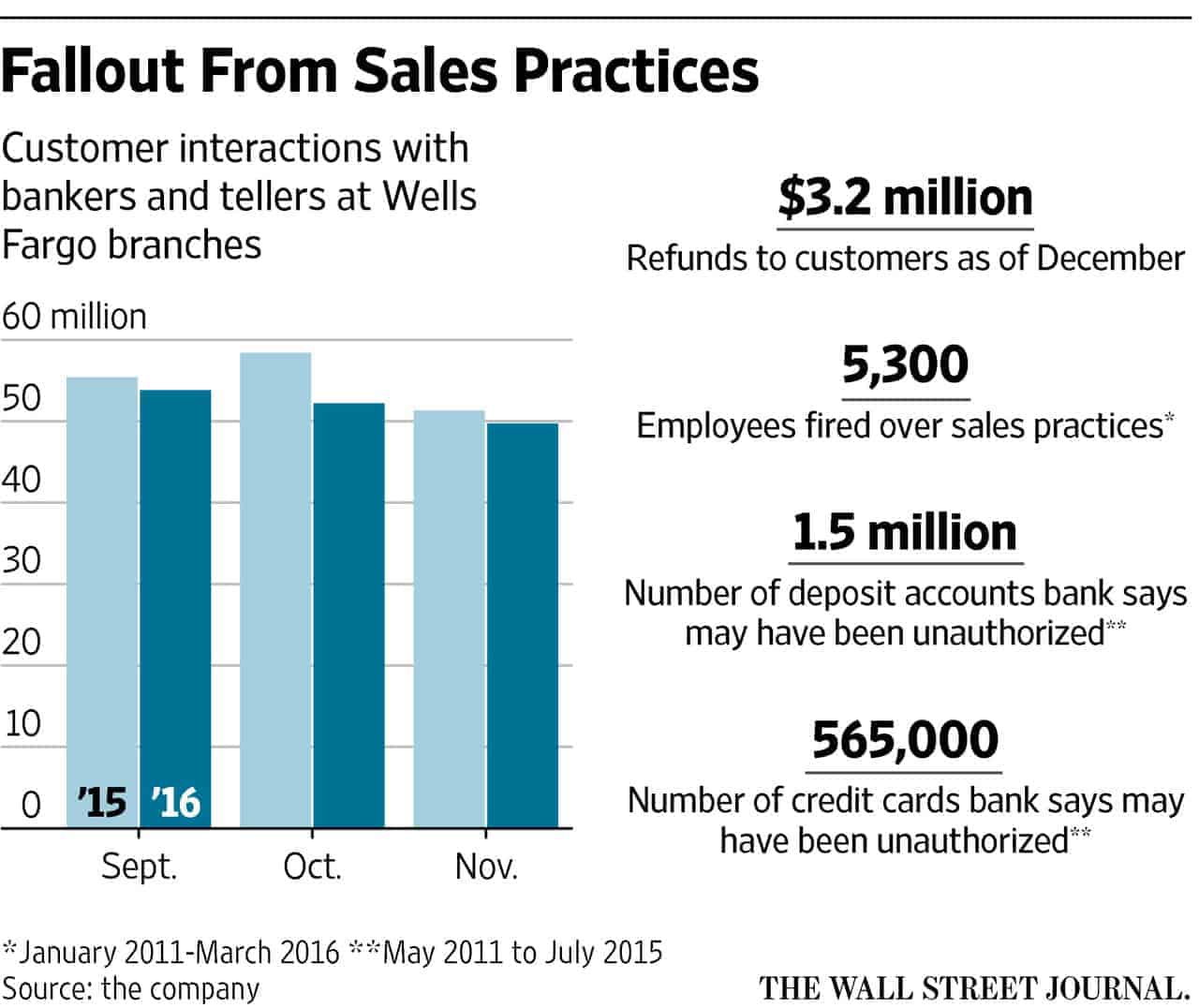
But, here's the worst part: this could've been prevented over a decade ago.
According to court documents, Wells Fargo's secretary Julie Tishkoff reported her suspicions in 2005:
"Tishkoff notified the bank's HR department about the illegal activities she saw, including employees forging customer signatures and opening accounts and credit cards for customers without their knowledge.
Wells Fargo faced similar complaints from other employees. However, the bank ignored the information and failed to open an investigation into the shady practices. (Julie Tishkoff v. Wells Fargo Bank, Ltd A California Corporation, 2011)."
She kept reporting her observations until she was fired in 2009.
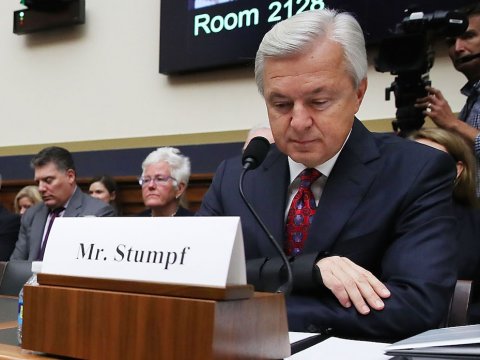
Much more than a few bad apples
Former CEO John Stumpf blamed the scandal on, "a few bad apples." However, according to former employees, it was the result of a toxic culture.
Employees were expected to follow the cross-selling strategy, "Going for Gr-Eight"; their mandate was to sell eight products per customer, because the more products a customer had, the more profit Wells Fargo generated with interests and fees.
Tishkoff wasn't the only one to report illegal activities in 2005. Former branch manager Dennis Hambek sent a letter to a regional leader about his suspicions:
"A customer applied for a mortgage loan at the Selah branch and was given a PMA checking, growth savings, and a debit card, opened by a PB located in Ellensburg. The customer stated he had never met with the PB or been to the Ellensburg Branch. He never signed any documents, or worse yet, never received any disclosures."
Hambek never got a response.
The corruption at Wells Fargo was systemic, not a few bad apples.
Leaders create the environment for toxic cultures to thrive
Blaming lower employees for business corruption is easy. However, public scandals like Wells Fargo show a bigger problem than a few workers misbehaving.
Toxic cultures exist because senior leaders allow it.
The academic journal Personnel Psychology released an article called, "A Trickle-Down Model of Abusive Supervision." Researchers theorized that upper management's lousy behavior enables middle and lower employees to act the same way.
Here is their model of abusive trickle-down supervision:

When a manager is abusive to their subordinate, that subordinate becomes abusive to their employees or co-workers.
But that's not all. When there's a hostile climate, like unreasonably high-sales pressure without accountability, the probability of abuse increases.
The lousy behavior of senior leaders not only affects their employees, it also affects the entire organization. The higher up the problematic person, the greater the damage.
This is what happened at Wells Fargo.
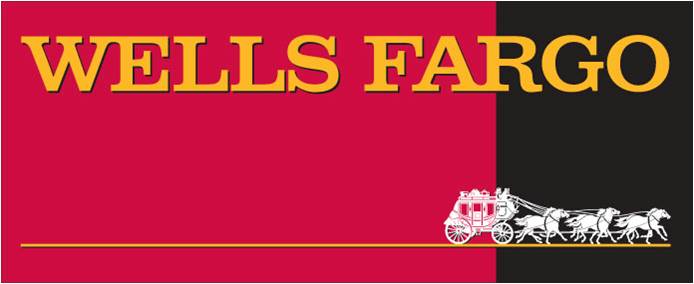
Wells Fargo's Trickle-Down Toxic Culture
Wells Fargo's toxic culture was present at every stage of their leadership hierarchy. Here's the Wells Fargo's version of the trickle down model:

Senior executives set high sales goals
Remember that regional leader Dennis Hambek sent a letter to? That was Carrie Tolstedt. She was also the head of Wells Fargo's Community Bank.

According to an investigation report, she escalated the sales pressure by tying sales goals to employee performance:
"Bankers, branch managers, and district managers risked pay cuts and poor performance reviews if they didn't hit the goals...and employees were ranked against one another."
We've covered before how bad stack ranking employees is for morale. However, it's not surprising that it was an element of such a toxic work culture.
Catchy name, bad behaviors
Tolstedt also created the "Jump to January" campaign. It was when the Community Bank enforced higher sales targets in January.
Whenever a colleague raised concerns about these high targets, Tolstedt ignored them. She didn't accept any criticism of her and the bank's toxic culture.
Tolstedt's leadership gave an impression that sales were the only way one could succeed:
"Employees...most likely to be praised, rewarded and held out as models for success were high sales performers."
She drilled this further by making Arizona Regional Banking's leader Pam Conboy the model of success.
Conboy enforced the "Jump to January" tradition throughout the year, causing bankers to push unnecessary products to customers.
The Trickle-Down: Regional leaders pressured branch managers
Tolstedt's pushy behavior trickled-down to regional leaders.
Erick Estrada told the LA Times how regional executives bullied branch managers. Every morning, they were reminded to fulfill their quotas. If they didn't, there was hell to pay:
"If you [didn't] make your goal, you [were] severely chastised and embarrassed in front of 60-plus managers in your area by the community banking president.”
According to the social learning theory, these managers had no reason to believe that their actions were wrong.
In "A Trickle-Down Model of Abusive Supervision," researchers claimed that abusive supervisors (regional leaders) are only doing what is accepted in the workplace. Since their bosses had no problem with their behavior, they had no reasons to stop.
A lawyer representing Wells Fargo employees echoed this:
"the better [managers] did at sales, the more they advanced, so it spread across the company. An entire generation of managers thrived in the culture, got rewarded for it, and are now in leadership positions.”
Trickle-Down to the Bottom: Bankers did the dirty work
Finishing the trickle-down model, managers pushed sales goals on local bankers. For example, Yesenia Guitron worked at Wells Fargo's St Helena branch.

The workplace culture was very intense. Every hour, managers would check up on her to see if she was meeting her quotas.
She wasn't. But, her co-workers were. Something was off.
Her lawsuit reported that it impossible for her branch to have high sales records:
"There were only about 11,500 potential customers in the area and 11 other financial institutions. The quotas for the bankers at Guitron's branch totaled 12,000 Daily Solutions each year, including almost 3,000 new checking accounts. Without fraud, the math didn't work."
Her co-workers were "gaming" the system at their customers' expense.
Guitron sent hundreds of printouts depicting suspicious activity to her managers. But, they didn't care. They told her to mind her business.
Escalation falls on deaf ears
Despite this, she didn't quit. Instead, she requested meetings with executives and made calls to Wells Fargo's Ethics Line.
Rather than listen to her concerns, in 2010, the bank fired her.
Years later, a fellow former St. Helena banker confessed that "gaming" was encouraged:
"It was normal...to use false identification on accounts and to change customers' names and open new accounts...Management made it clear that no employee was allowed to complain about the unethical practices that were going on within the branch.”
A Houston teller, who transferred between many branches, discovered that they all shared the same shady practices. Wells Fargo's toxic culture had spread nationwide.
The High Costs of a Toxic Culture
Having a toxic culture hurts your business in the long-run in a variety of ways. It lowers work performance, damages public perception of you and your brand, and it hurts customer's trust.
All are consequences that take years to overcome.
Disengaged workers are expensive
Two professors at Concordia University in Montreal wrote a paper on unhealthy companies. It's called, "Toxins in the workplace: Affect on organizations and employees."
They found that organizations like Wells Fargo are hurting their workers' self-esteem, creating a less engaged workplace.
This table from their paper shows that companies with high people management practices (PMP) tend to have higher financial returns than ones that low PMP.

Companies with low PMP suffer from low productivity and high absenteeism. Their employees are more likely to take sick days, abandon workloads, and quit early. This is in line with the myriad of data we've covered on employee disengagement studies by Gallup.
These disengaged workers cost the U.S. between $450 billion to $550 billion in lost productivity every year.
A report from CareerBuilder found that 69% of HR managers and professionals have been negatively affected by a bad employee. Meanwhile, 65% of managers estimated that this bad employee cost them between $25,000 and $50,000 in lost time and productivity.
In the case of Wells Fargo, an investigative report revealed that one of their Community Banks once had an employee turnover rate of 42%!
Long-term struggles to overcome
Wells Fargo's fake account scandal ruined its reputation. Today, the majority of Americans don't trust the bank with their money.
This distrust showed in their financial reporting. In 2017, their net income was $5.5 billion, which meant they had zero growth from the year before. Even worse, their revenue dropped by $200 million.
Not surprisingly, according to the American Banker, Wells Fargo has the lowest overall bank reputation ranking.

Customers and Non-Customers perceive their brand to be very weak. This means that people are less likely to buy, invest, and apply for a job at Wells Fargo.

In January, the bank announced their plan to close 800 branches by 2020. This is because they're trying to save money for their legal expenses and damages.
So far, they spent about $3.3 billion in legal bills. Yet, the worst isn't over for them. They're expecting more victim lawsuits in the future.
The consulting firm, cg42, believes that Wells Fargo could lose 14% of their customer base. They also predict that they could lose about $99 billion in deposits and $4 billion in revenues in upcoming years.

As of yesterday, the Federal Reserve will halt the firm's growth, "until it sufficiently improves its governance and controls.” Meaning, that the bank can't grow beyond its $1.95 trillion in assets.
When customers don't trust a company, the company tends to pay a high price. Wells Fargo is now paying for years of bad behavior and toxic culture.
You are responsible for your culture.
Don't want a toxic culture like Wells Fargo? Then, you must live and enforce your corporate values.
You're much more than an authority figure and decision maker as a leader at your company. You're the standard of what is accepted within your business.
Live your values like Red Hat
One company that embraces this is Red Hat. Their CEO's attitude represents their culture quite clearly.
Jim Whitehurst encourages employees to have candid discussions about their mistakes. He believes that the more his people embrace failure, the more innovative they become:
"By accepting and even celebrating a failed effort, we promote innovation. We will reward someone who tries to climb the tallest mountain, even if they fall short of the summit because they have created an experience we can learn from and build upon. That's what innovation is all about."
Investment in learning is a value that can help any team. HBR reported that great managers tend to make more great managers, while poor managers create more poor leaders.
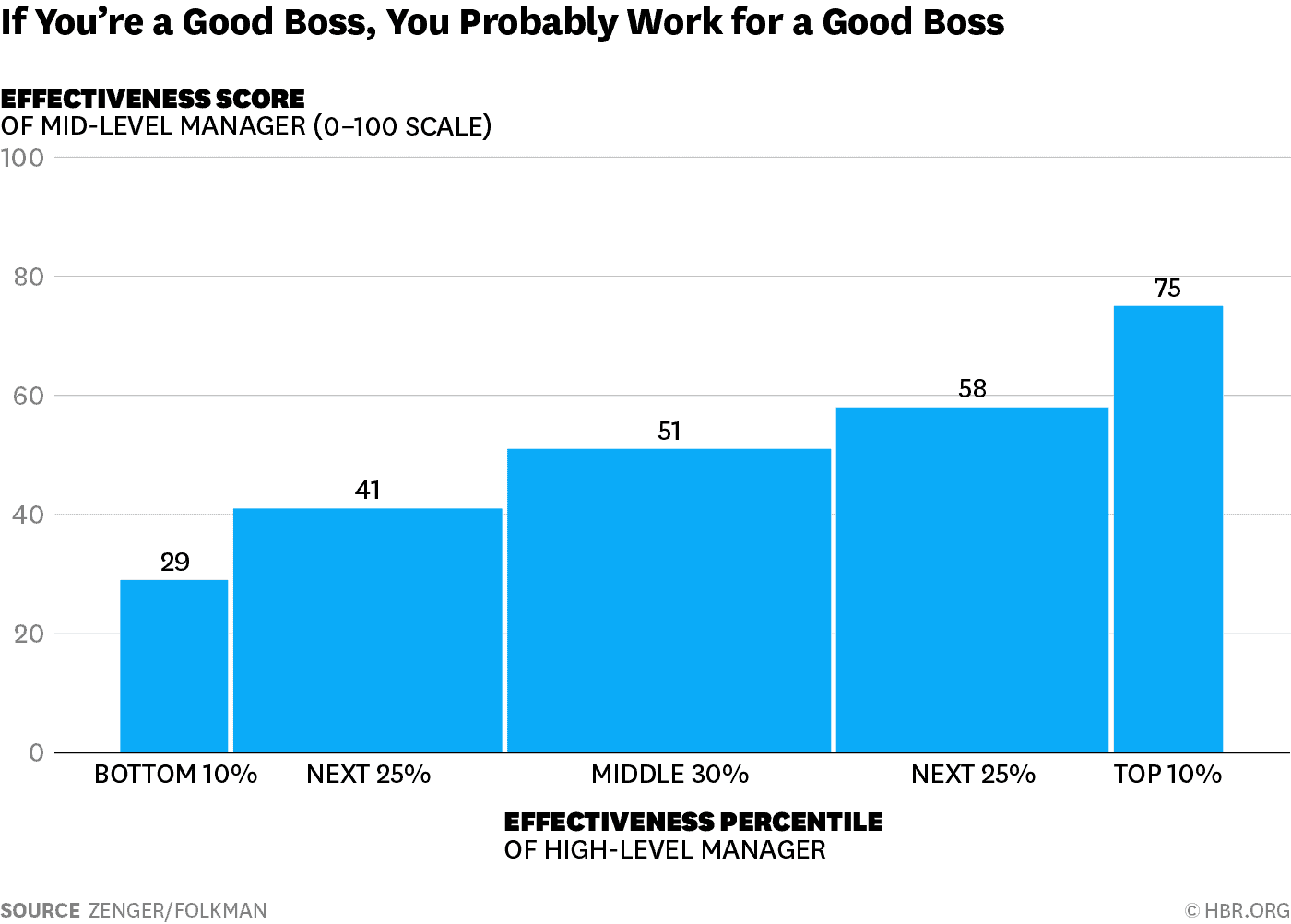
How to find out if you have a toxic culture
The first part of transforming a toxic culture is to determine if there is one.
You can do this by reading:
- Online company reviews
- Gathering employee feedback
Sites like Glassdoor and Indeed allow former employees to share details about a company's culture. They often cut through any glamour or hype around a business.
For example, here's one of quite a few negative reviews of Gary Vaynerchuck's digital agency, Vaynermedia.
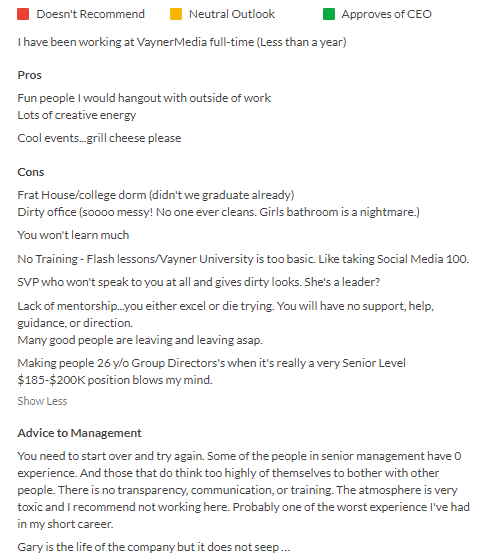
For all his social media hype and fandom, there seems to be quite a few cultural issues. Employees experienced a "high-school” like culture. Special benefits were given to only certain people.
In contrast, McKinsey's reviews illustrate a more positive workplace.
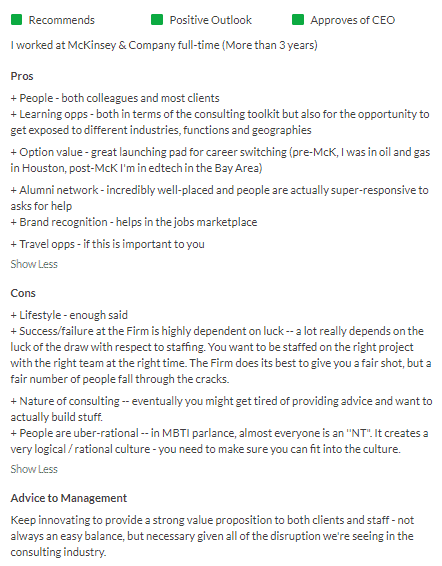
Read your profile to discover what past employees think about you when they're given the protection of anonymity.
Look at your managers
In addition to anonymous feedback career sites, another place to look is to get manager insight from your employees. Hulu did this with their customers and employees.
Head of customer experience, Michael Callahan, wanted to increase customer retention. This was a priority, because they found that improving retention by 1% could generate an extra $11 million in annual revenue.
So, his team created a system linking employee to customer feedback. After a transaction, surveys were sent to both parties.
These surveys allowed his department to identify blind spots within the employee and customer interactions. Managers used the feedback to better coach employees on how to engage with customers.
You can introduce a similar system with your employees as the customers of your managers.
Having employees give feedback on their experiences can help improve your managers and your culture.
You can promote good behavior by rewarding managers for decreasing employee turnover, and living your values.
This strategy could save you thousands of dollars every year. Hulu's customer support employees received a bonus for every subscriber that stayed subscribed for 30 days after their interaction, and saw great returns as a business.
You must embody your values
Great leaders practice their culture's values. Narayana Murthy is the former CEO of Infosys, a multi-billion dollar software company.
In a case study by INSEAD, Murthy shares his top leadership secret:
"I truly believe in leadership by example. I have realized that it is the most powerful way of creating trust in your ideas. Before telling somebody to do something, you must do it yourself.”
Here are Infosys's core values:
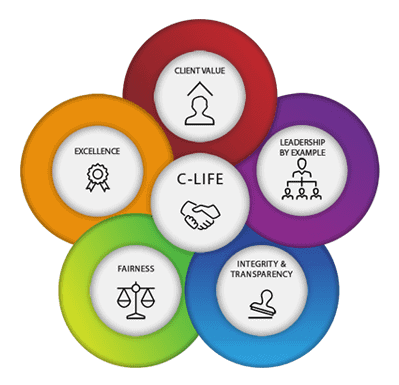
Just as important as writing great values, their leaders put these values into action:
- They live a modest life. Infosys's founders are some of the wealthiest men in India. But, they live in small houses and use public transportation so they can relate to their employees.
- They offer mutual respect. Top leaders read and reply to emails from every employee no matter the subject; it can be business or personal.
- They make decisions based on data, not personalities. Leaders do not use their authority to make a decision. Every employee's opinion is valuable if supported by data. This creates a fairer workplace.
- They keep their promises. For example, Infosys pledges an open culture. So, every office has an open door that anyone can walk into.
- They prioritize growth. They test new ideas every six months. Then, they share the findings online.
Conclusion
Wells Fargo ruined the lives of millions of people. Sadly, this could've been prevented. But, senior executives were too greedy. They preferred a toxic culture over truly serving their customers.
The push for and acceptance of bad behavior trickled down to every level of management. Then, they ignored fraud complaints until it was too late.
Since the scandal broke, Wells Fargo pledged to eliminate high-pressure sales targets.
They also agreed to pay millions in fees:
- $6.1 million in customer refunds
- $910,000 to victims of online errors
- $142 million in a national class action settlement
- $185 million to city and federal regulators
But to echo Sen. Elizabeth Warren's tweets:
For months, I have repeatedly pressed Janet Yellen to hold Wells Fargo accountable for its fake accounts scam and push out responsible Board Members. Today she did it – in her last act as Fed Chair. pic.twitter.com/ebIkhu8R0a
— Elizabeth Warren (@SenWarren) February 3, 2018
A toxic culture will always catch up with you eventually
Wells Fargo is a great example of what NOT to do. You don't want to spend millions in fines because you caught problems too late, and let ethical issues spiral out of control.
Ask yourself: Would you open a bank account with them today?
Don't let your customers question your company too.





